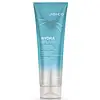What's inside
What's inside
 Key Ingredients
Key Ingredients

No key ingredients
 Benefits
Benefits

 Concerns
Concerns

 Ingredients Side-by-side
Ingredients Side-by-side

Water
Skin ConditioningCetearyl Alcohol
EmollientBehentrimonium Chloride
PreservativeIsopropyl Palmitate
EmollientStearyl Alcohol
EmollientPropylene Glycol
HumectantPhenoxyethanol
PreservativeEthylhexyl Olivate
Skin ConditioningCocos Nucifera Oil
MaskingHelianthus Annuus Seed Oil
EmollientRosa Canina Fruit Oil
EmollientLaurdimonium Hydroxypropyl Hydrolyzed Keratin
Skin ConditioningPhosphatidylcholine
EmulsifyingArginine Hcl
Skin ConditioningHydrolyzed Algin
Sea Water
HumectantChlorella Vulgaris Extract
Skin ConditioningDipropylene Glycol
HumectantCetyl Esters
EmollientHydroxyethylcellulose
Emulsion StabilisingBisamino PEG/PPG-41/3 Aminoethyl Pg-Propyl Dimethicone
Carthamus Tinctorius Seed Oil
MaskingGuar Hydroxypropyltrimonium Chloride
Skin ConditioningPolyquaternium-37
Isostearyl Ethylimidazolinium Ethosulfate
Tetrasodium Glutamate Diacetate
Propylene Glycol Dicaprylate/Dicaprate
EmollientPEG-4 Laurate
EmulsifyingPEG-14m
Emulsion StabilisingStyrene/Butadiene Copolymer
Squalane
EmollientCitric Acid
BufferingPPG-1 Trideceth-6
Skin ConditioningIsopropyl Alcohol
SolventSodium Hydroxide
BufferingIodopropynyl Butylcarbamate
PreservativeSodium Benzoate
MaskingPotassium Sorbate
PreservativeLinalool
PerfumingLimonene
PerfumingParfum
MaskingCI 42090
Cosmetic ColorantCI 60730
Cosmetic ColorantCI 19140
Cosmetic ColorantWater, Cetearyl Alcohol, Behentrimonium Chloride, Isopropyl Palmitate, Stearyl Alcohol, Propylene Glycol, Phenoxyethanol, Ethylhexyl Olivate, Cocos Nucifera Oil, Helianthus Annuus Seed Oil, Rosa Canina Fruit Oil, Laurdimonium Hydroxypropyl Hydrolyzed Keratin, Phosphatidylcholine, Arginine Hcl, Hydrolyzed Algin, Sea Water, Chlorella Vulgaris Extract, Dipropylene Glycol, Cetyl Esters, Hydroxyethylcellulose, Bisamino PEG/PPG-41/3 Aminoethyl Pg-Propyl Dimethicone, Carthamus Tinctorius Seed Oil, Guar Hydroxypropyltrimonium Chloride, Polyquaternium-37, Isostearyl Ethylimidazolinium Ethosulfate, Tetrasodium Glutamate Diacetate, Propylene Glycol Dicaprylate/Dicaprate, PEG-4 Laurate, PEG-14m, Styrene/Butadiene Copolymer, Squalane, Citric Acid, PPG-1 Trideceth-6, Isopropyl Alcohol, Sodium Hydroxide, Iodopropynyl Butylcarbamate, Sodium Benzoate, Potassium Sorbate, Linalool, Limonene, Parfum, CI 42090, CI 60730, CI 19140
Zinc Pyrithione 0.5%
AntiseborrhoeicWater
Skin ConditioningCetearyl Alcohol
EmollientBehentrimonium Chloride
PreservativeGlycerin
HumectantPEG-180
HumectantAmodimethicone
Cetyl Esters
EmollientCeramide NP
Skin ConditioningCeramide AP
Skin ConditioningCeramide EOP
Skin ConditioningCarbomer
Emulsion StabilisingNiacinamide
SmoothingTrideceth-6
EmulsifyingTriethyl Citrate
MaskingSodium Lauroyl Lactylate
EmulsifyingSodium Hyaluronate
HumectantSodium Polynaphthalenesulfonate
Emulsion StabilisingSodium Chloride
MaskingSodium Phosphate
BufferingCholesterol
EmollientPhenoxyethanol
PreservativeChlorhexidine Dihydrochloride
AntimicrobialDisodium Phosphate
BufferingIsopropyl Alcohol
SolventPropylene Glycol
HumectantHydroxyethylcellulose
Emulsion StabilisingCetrimonium Chloride
AntimicrobialCaprylyl Glycol
EmollientXanthan Gum
EmulsifyingPhytosphingosine
Skin ConditioningPolysorbate 60
EmulsifyingBenzoic Acid
MaskingZinc Pyrithione 0.5%, Water, Cetearyl Alcohol, Behentrimonium Chloride, Glycerin, PEG-180, Amodimethicone, Cetyl Esters, Ceramide NP, Ceramide AP, Ceramide EOP, Carbomer, Niacinamide, Trideceth-6, Triethyl Citrate, Sodium Lauroyl Lactylate, Sodium Hyaluronate, Sodium Polynaphthalenesulfonate, Sodium Chloride, Sodium Phosphate, Cholesterol, Phenoxyethanol, Chlorhexidine Dihydrochloride, Disodium Phosphate, Isopropyl Alcohol, Propylene Glycol, Hydroxyethylcellulose, Cetrimonium Chloride, Caprylyl Glycol, Xanthan Gum, Phytosphingosine, Polysorbate 60, Benzoic Acid
Ingredients Explained
These ingredients are found in both products.
Ingredients higher up in an ingredient list are typically present in a larger amount.
This ingredient is a preservative and often used for it's anti-static properties. You'll most likely see this ingredient in hair conditioners.
It does not cause irritation or sensitization in leave-on products at 1-5%.
Cetearyl alcohol is a mixture of two fatty alcohols: cetyl alcohol and stearyl alcohol. It is mainly used as an emulsifier. Emulsifiers help prevent the separation of oils and products. Due to its composition, it can also be used to thicken a product or help create foam.
Cetearyl alcohol is an emollient. Emollients help soothe and hydrate the skin by trapping moisture.
Studies show Cetearyl alcohol is non-toxic and non-irritating. The FDA allows products labeled "alcohol-free" to have fatty alcohols.
This ingredient is usually derived from plant oils such as palm, vegetable, or coconut oils. There is debate on whether this ingredient will cause acne.
Due to the fatty acid base, this ingredient may not be Malassezia folliculitis safe.
Learn more about Cetearyl AlcoholCetyl Esters is a synthetic wax made up of mostly fatty acids and fatty alcohols. It is strcturally similar to wax taken from whales.
As an emollient, it creates a thin barrier on the skin. This barrier prevents moisture from escaping.
This ingredient may not be fungal-acne safe.
Learn more about Cetyl EstersHydroxyethylcellulose is used to improve the texture of products. It is created from a chemical reaction involving ethylene oxide and alkali-cellulose. Cellulose is a sugar found in plant cell walls and help give plants structure.
This ingredient helps stabilize products by preventing ingredients from separating. It can also help thicken the texture of a product.
This ingredient can also be found in pill medicines to help our bodies digest other ingredients.
Learn more about HydroxyethylcelluloseIsopropyl Alcohol is more commonly known as rubbing alcohol. It is most commonly used as a solvent, meaning it helps other ingredients dissolve.
This ingredient is an astringent alcohol. Astringent alcohols may also irritate skin as they high amounts may strip away your skin's natural oils.
Other types of astringent alcohols include:
According to the National Rosacea Society based in the US, you should be mindful of products with these alcohols in the top half of ingredients.
Any type of sanitizing product will have high amounts of alcohol to help kill bacteria and viruses.
Learn more about Isopropyl AlcoholPhenoxyethanol is a preservative that has germicide, antimicrobial, and aromatic properties. Studies show that phenoxyethanol can prevent microbial growth. By itself, it has a scent that is similar to that of a rose.
It's often used in formulations along with Caprylyl Glycol to preserve the shelf life of products.
Propylene Glycol is an odorless, colorless liquid. As a humectant, it helps skin retain moisture. It also aids in delivering active ingredients.
Another role of this ingredient is preventing a product from melting or freezing. Propylene glycol also adds antimicrobrial properties to a product, elongating product lifespan.
This ingredient is considered an organic alcohol and commonly added into both cosmetics and foods.
Those with sensitive skin or conditions may develop a rash when using this ingredient.
Learn more about Propylene GlycolWater. It's the most common cosmetic ingredient of all. You'll usually see it at the top of ingredient lists, meaning that it makes up the largest part of the product.
So why is it so popular? Water most often acts as a solvent - this means that it helps dissolve other ingredients into the formulation.
You'll also recognize water as that liquid we all need to stay alive. If you see this, drink a glass of water. Stay hydrated!
Learn more about Water